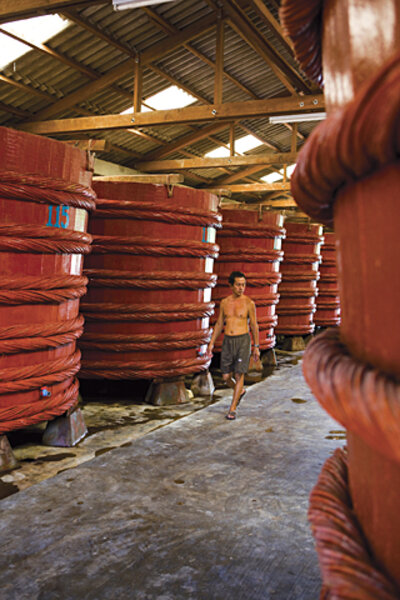Pungent pleasure: fish sauce secrets in Vietnam
Loading...
| Phan Thiet, Vietnam
In Normandy, a traveler might stop to pick up a few rounds of Camembert. In Spain, you can nibble on delicious Iberian acorn ham while standing in a forest of suspended hams at a Seville charcuterie. In Vietnam, the specialty is nuoc mam, and I was keen to sample some of this highly prized fish sauce in its purest form.
My quest took me to Phan Thiet, a beach town located about 125 miles from Ho Chi Minh City. In recent years, this picturesque area has been popularized as one of Asia’s top kite-surfing destinations. But the region’s main industry – fishing and the manufacture of fish sauce – is still going strong.
The distinct – and stinky – brown liquid forms the foundation of the country’s rich and varied cuisine and is a fixture at almost every meal. Nuoc mam can be used at any stage of the cooking process – as a marinade for meat or a stock base and it can be added directly to a dish for flavor or diluted to create a light dipping sauce. It’s one of Vietnam’s proudest culinary traditions.
There are about 600 nuoc mam factories of varying sizes in Binh Thuan Province, which produce a combined total of 9-1/2 million gallons of the pungent sauce a year. Phan Thiet and the nearby town of Mui Ne are considered leading sources, and an excursion to one of the local factories is an interesting, albeit overwhelming, sensory experience.
At Phan Thiet’s Fish Sauce Joint Stock Co. (FISACO), which produces more than 4 million gallons of nuoc mam a year under four brand names, curious gastronomes are offered a tour to see the process and sample some of the end products.
As we stood among wooden barrels surrounded by an assortment of bottles, the aroma was not unpleasant: rich, acrid, and meaty, reminiscent of Worcestershire sauce and Bovril, the British meat extract. The caramel-colored liquid tasted salty and a bit like salmon. When used as dip, marinade, or sauce base, nuoc mam is commonly mixed with lime juice, water, and sugar.
“Anchovies or salmon are best, but you can use pretty much any fish [in making the sauce],” explained the tour guide. “We collect ours from the port or market as soon as the fishermen dock every morning. The fast option is to put fish into cylindrical 30-ton-capacity wooden tanks at a ratio of 10 [parts] fish to 4 [parts] salt, or 3 [parts] fish to 1 [of] salt,” he continued. “Runoff from the fish is removed through a hole in the bottom of the tank, and put through the tank again and again. Within five days, we can take the first fish sauce.”
Once the first sauce has been decanted, manufacturers will add more salt and water to produce another 16 gallons of a lower-grade product.
“The other, more traditional method,” our guide explained, “is to layer fish sauce and salt in jars under the sun and wait for three months while natural hydrolysis occurs.”
This method has been used by fishing families in Binh Thuan Province for generations. Most don’t offer tours, but just mentioning my interest at a beachfront cafe was enough to secure an invitation to the nuoc mam shop belonging to the uncle of a staff member. After a short motorbike ride, I found myself in a shed along the main stretch of Mui Ne beach.
Under the shade of a corrugated iron roof fringed by coconut trees, a girl squatted over a collection of bowls . Catching sight of us, she waved cheerily and gestured toward the yard out back, where immense clay jars were arranged in three haphazard rows under the midday sun. Some were topped with bamboo lids, some capped with recycled rubber tires, and all were elevated off the ground on chunks of brick. Each jar contained a mixture of rotting, fermenting fish that could singe nose hair at 100 paces.
“It’s very important to keep the temperature constantly high,” explained my waitress-cum-tour guide Nhu. “A higher temperature means better fish sauce. After a few months, you draw the nuoc mam off and filter it. Each of these jars has a capacity of 400 liters [106 gallons], and the first tapping will give 100 liters [26 gallons] of premium nuoc mam.”
I decided to go in search of some of Phan Thiet’s more pleasurable aromas. About 22 miles south of the FISACO factory, I found the perfect restorative for my sense of smell. At Princess d’Annam Resort, the villas sit among sprawling gardens designed by Alan Carle, who also is responsible for the Ginger Garden at the Singapore Botanic Gardens
I headed for the resort’s two-story, U-shaped spa, which is set right on the oceanfront. The spa manager suggested I enjoy a hot herbal jacuzzi to help soak away the stink of my day at the factory, and within minutes I was sinking beneath hot waters that bubbled with the aroma of ginger and lemon grass. Next came a deliciously cooling peppermint body scrub that blended leaves just plucked from the resort’s herb gardens. Then I enjoyed a sweet mango body wrap.
My day had taken my nose from one extreme to the other, and left me feeling as though I had truly experienced the essence of Phan Thiet. How often can you say that after a single day’s exploration of a new destination?
---
Related stories:
Little Tokyo, Los Angeles: Getting the flavor of the place
Discover good food in Buenos Aires
Macarons conquer Paris, now London
Indian Food: Vada Pav, Mumbai's chutney-slathered vegetarian food







